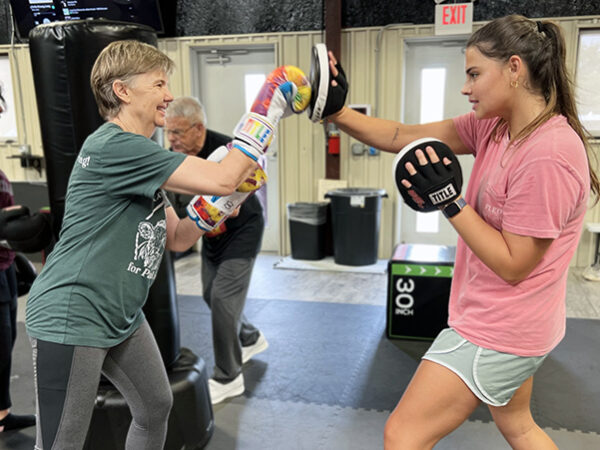Finding effective ways to teach children with autism
Finding effective ways to teach children with autism has long been a passion for Dr. Julie Thompson, assistant professor of special education.
Through her BLINC (Biometric Literacy and Language Indicators for Neurodevelopmental Disorders in Children) Lab, Thompson researches how to improve literacy and language skills of children with neurodevelopmental disorders such as autism, down syndrome and other intellectual disabilities.
Todos Juntos, Everybody
Students with autism have individualized needs in the classroom. While many educators feel one-on-one instruction is required, research shows group instruction is also successful. However, Thompson said teachers should focus on ways to enhance the group instruction to meet those individualized needs.
One way is through direct instruction, or DI. DI includes clear, consistent and precise directions and materials that promote student mastery. It is designed for small-group instruction and relies heavily on unison responding, or having all students respond at the same time.
“I would first do a mini lesson with a student. I taught them that ‘everybody’ is the same as saying their name. If I say ‘Denise’, Denise should respond to me,” said Thompson. “I would go between the word ‘everybody’ and a child’s name so the students learned when it wasn’t their name or the word everybody, they shouldn’t respond.”
She wanted to get more specific and investigate certain strategies and the impact on students with autism, specifically those who previously had trouble participating in small-group instruction because of interfering behaviors.
Thompson took a closer look at task breaks in combination with proximity fading, or changing the distance between the teacher and the student. The study found a significant improvement in student participation when those strategies were used in conjunction with group instruction.
“What you see is the kids learn and problem behaviors are reduced if they’re engaged. If you have good instruction, a lot of the problem behaviors go away. It’s a combination of being a really good teacher and having some behavior supports when needed,” said Thompson.
Thompson was surprised by another finding during the research. One of the student participants primarily spoke Spanish in the classroom and at home. Unlike her peers, she was not able to master the unison responding. Thompson took her concerns to a diversity expert.
The expert suggested she use the phrase “todos juntos” which means “all together.” Soon after implementing the new phrase, Thompson noticed a change in the student’s behavior.
“You have children that can’t respond to teacher instruction and they don’t always know that they are the focus of teacher instruction. We need to train teachers to consistently use a word, whether it’s ‘everybody’ or ‘you all’ or anything. They key is to consistently use that phrase so the student knows to respond,” said Thompson.
Eye Tracking and E-books
Another piece of Thompson’s research focused on electronic books. E-books have been used for years but are quickly growing in popularity. The growth has prompted a debate about whether e-books help or hurt literacy development.
While e-books appear to be beneficial for improving literacy skills for children without disabilities, research has shown that children with autism who are minimally verbal may not be as responsive to those types of passive instructional activities.
 Using eye-tracking technology, Thompson measured the attention to print and pictures in an e-book from both elementary students with autism and elementary students with typical development.
Using eye-tracking technology, Thompson measured the attention to print and pictures in an e-book from both elementary students with autism and elementary students with typical development.
She found children with minimally verbal autism only paid attention to the book half the time it was displayed. The children spent an even shorter amount of time looking at the words and/or pictures in the e-book.
However, when the text was read aloud and highlighted, more attention was paid to the words. Thompson said this shows simple stimulus enhancements may help get the attention of children with autism. She said it is important to draw attention to text and pictures intentionally.
“We think e-books and technology are this amazing thing, but not without behavioral supports and directed instruction to get children to look,” said Thompson. “For children with autism, we need to move back and teach them how to construct meaning by actually getting them to engage and look at pictures as they’re hearing the words. When they hear the word dog, we want them to know there’s a dog on the page and they have to identify that.”
Thompson calls for future research to examine eye gaze during traditional book reading to determine any similarities and further investigate ways to better educate students with autism.
Current and Future Research
Thompson is currently working on a grant from the Texas Higher Education Coordinating Board to help parents with reading to their children and using it as an opportunity to promote language.
Based on successes in an earlier grant, Thompson and her research team are working with Spanish-speaking families to promote reading, specifically for children who have very limited language or problem behaviors that interfere with their ability to read.
Results from the research will be released Spring 2020.
About the Writer
Ashley is the Media Relations Coordinator and responsible for news coverage in the Department of Teaching, Learning and Culture as well as the Department of Educational Psychology.
Articles by AshleyFor media inquiries, contact Ashley Green.
Fundraising
To learn more about how you can assist in fundraising, contact Amy Hurley, Director of Development ahurley@txamfoundation.com or 979-847-9455














